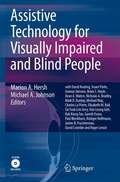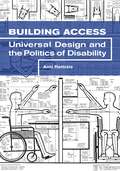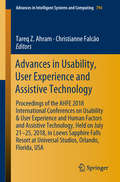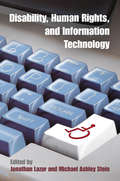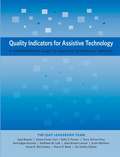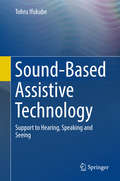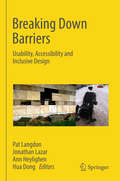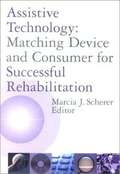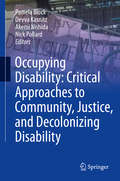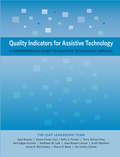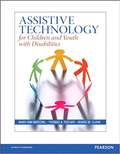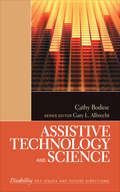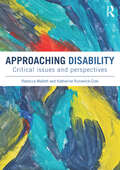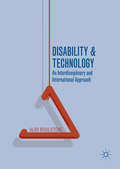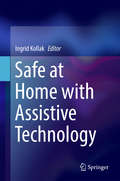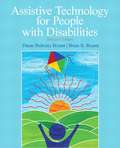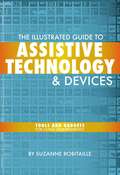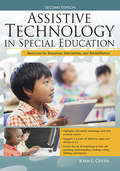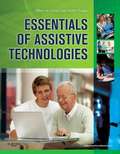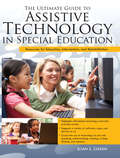Special Collections
Assistive Technology
Description: A diverse collection of textbooks detailing assistive technology for people with a diverse range of disabilities. #disability
- Table View
- List View
Assistive Technology for Visually Impaired and Blind People
by Marion A. Hersh and Michael A. JohnsonEqual accessibility to public places and services is now required by law in many countries. In the case of the vision-impaired, it is often the use of specialised technology which can provide them with a fuller enjoyment of all the facilities of society from large scale meetings and public entertainments to the more personal level of reading a book or making music. In this volume the engineering and design principles and techniques used in assistive technology for blind and vision-impaired people are explained. Features:· instruction in the physiology of the human visual system and methods of measuring visual ability;· explanation of many devices designed for every-day living in terms of generic electrical engineering principles;· sections of practical projects and investigations which will give the reader ideas for student work and for self teaching;· contributions by authors of international repute from divers fields which co-operate under the banner of assistive technology, among them: artificial vision systems; psychology, haptics, electrical engineering, design and visual physiology. Assistive Technology for Vision-impaired and Blind People is an an effective means of maintaining the currency of knowledge for engineers and health workers working to provide devices and/or services for people with sight loss and an excellent source of reference for students working in assistive technology and rehabilitation.
Building Access
by Aimi Hamraie&“All too often,&” wrote disabled architect Ronald Mace, &“designers don&’t take the needs of disabled and elderly people into account.&” Building Access investigates twentieth-century strategies for designing the world with disability in mind. Commonly understood in terms of curb cuts, automatic doors, Braille signs, and flexible kitchens, Universal Design purported to create a built environment for everyone, not only the average citizen. But who counts as &“everyone,&” Aimi Hamraie asks, and how can designers know? Blending technoscience studies and design history with critical disability, race, and feminist theories, Building Access interrogates the historical, cultural, and theoretical contexts for these questions, offering a groundbreaking critical history of Universal Design. Hamraie reveals that the twentieth-century shift from &“design for the average&” to &“design for all&” took place through liberal political, economic, and scientific structures concerned with defining the disabled user and designing in its name. Tracing the co-evolution of accessible design for disabled veterans, a radical disability maker movement, disability rights law, and strategies for diversifying the architecture profession, Hamraie shows that Universal Design was not just an approach to creating new products or spaces, but also a sustained, understated activist movement challenging dominant understandings of disability in architecture, medicine, and society.Illustrated with a wealth of rare archival materials, Building Access brings together scientific, social, and political histories in what is not only the pioneering critical account of Universal Design but also a deep engagement with the politics of knowing, making, and belonging in twentieth-century United States.
Advances in Usability, User Experience and Assistive Technology
by Tareq Z. Ahram and Christianne FalcãoThis book focuses on emerging issues in usability, interface design, human–computer interaction, user experience and assistive technology. It highlights research aimed at understanding human interaction with products, services and systems, and focuses on finding effective approaches for improving user experience. It also discusses key issues in designing and providing assistive devices and services to individuals with disabilities or impairment, to assist mobility, communication, positioning, environmental control and daily living. The book covers modelling as well as innovative design concepts, with a special emphasis on user-centered design, and design for specific populations, particularly the elderly. Virtual reality, digital environments, heuristic evaluation and forms of device interface feedback of (e.g. visual and haptic) are also among the topics covered. Based on the AHFE 2018 Conference on Usability & User Experience and the AHFE 2018 Conference on Human Factors and Assistive Technology, held on July 21–25, 2018, in Orlando, Florida, USA, this book reports on cutting-edge findings, research methods and user-centred evaluation approaches.
Disability, Human Rights, and Information Technology
by Jonathan Lazar and Michael SteinDisability, Human Rights, and Information Technology addresses the global issue of equal access to information and communications technology (ICT) by persons with disabilities. The right to access the same digital content at the same time and at the same cost as people without disabilities is implicit in several human rights instruments and is featured prominently in Articles 9 and 21 of the Convention on the Rights of Persons with Disabilities.
The right to access ICT, moreover, invokes complementary civil and human rights issues: freedom of expression; freedom to information; political participation; civic engagement; inclusive education; the right to access the highest level of scientific and technological information; and participation in social and cultural opportunities.
Despite the ready availability and minimal cost of technology to enable people with disabilities to access ICT on an equal footing as consumers without disabilities, prevailing practice around the globe continues to result in their exclusion. Questions and complexities may also arise where technologies advance ahead of existing laws and policies, where legal norms are established but not yet implemented, or where legal rights are defined but clear technical implementations are not yet established.
At the intersection of human-computer interaction, disability rights, civil rights, human rights, international development, and public policy, the volume's contributors examine crucial yet underexplored areas, including technology access for people with cognitive impairments, public financing of information technology, accessibility and e-learning, and human rights and social inclusion.
Contributors: John Bertot, Peter Blanck, Judy Brewer, Joyram Chakraborty, Tim Elder, Jim Fruchterman, G. Anthony Giannoumis, Paul Jaeger, Sanjay Jain, Deborah Kaplan, Raja Kushalnagar, Jonathan Lazar, Fredric I. Lederer, Janet E. Lord, Ravi Malhotra, Jorge Manhique, Mirriam Nthenge, Joyojeet Pal, Megan A. Rusciano, David Sloan, Michael Ashley Stein, Brian Wentz, Marco Winckler, Mary J. Ziegler.
Quality Indicators For Assistive Technology
by The QIAT Leadership TeamMore than 6 million children with disabilities in North America require assistive technology and related services each year in order to participate and succeed in school. This book, Quality Indicators for Assistive Technology, provides an essential guide for assessing a child's needs, choosing and implementing the right technologies and services, and training education professionals in how to optimize learning with these critical tools.
Sound-Based Assistive Technology
by Tohru IfukubeThis book presents a technology to help speech-, hearing- and sight-impaired people. It explains how they will benefit from an enhancement in their ability to recognize and produce speech or to detect sounds in their surroundings. Additionally, it is considered how sound-based assistive technology might be applied to the areas of speech recognition, speech synthesis, environmental recognition, virtual reality and robots. The primary focus of this book is to provide an understanding of both the methodology and basic concepts of assistive technology rather than listing the variety of assistive devices developed. This book presents a number of different topics which are sufficiently independent from one another that the reader may begin at any chapter without lacking background information. Much of the research quoted in this book was conducted in the author's laboratories at Hokkaido University and University of Tokyo. This book offers the reader a better understanding of a number of unsolved problems that still persist in the field of sound-based assistive technology.
Advances in Usability, User Experience and Assistive Technology
by Christianne Falcão and Tareq Z. AhramThis book focuses on emerging issues in usability, interface design, human–computer interaction, user experience and assistive technology. It highlights research aimed at understanding human interaction with products, services and systems, and focuses on finding effective approaches for improving user experience. It also discusses key issues in designing and providing assistive devices and services to individuals with disabilities or impairment, to assist mobility, communication, positioning, environmental control and daily living. The book covers modelling as well as innovative design concepts, with a special emphasis on user-centered design, and design for specific populations, particularly the elderly. Virtual reality, digital environments, heuristic evaluation and forms of device interface feedback of (e.g. visual and haptic) are also among the topics covered. Based on the AHFE 2018 Conference on Usability & User Experience and the AHFE 2018 Conference on Human Factors and Assistive Technology, held on July 21–25, 2018, in Orlando, Florida, USA, this book reports on cutting-edge findings, research methods and user-centred evaluation approaches.
Breaking Down Barriers
by Hua Dong and Ann Heylighen and Jonathan Lazar and Pat LangdonThe Cambridge Workshops on Universal Access and Assistive Technology (CWUAAT) is one of the few gatherings where people interested in inclusive design, across different fields, including designers, computer scientists, engineers, architects, ergonomists, ethnographers, policymakers and user communities, meet, discuss, and collaborate. CWUAAT has also become an international workshop, representing diverse cultures including Portugal, Germany, Trinidad and Tobago, Canada, Australia, China, Norway, USA, Belgium, UK, and many more. The workshop has five main themes based on barriers identified in the developing field of design for inclusion: I Breaking Down Barriers between Disciplines II Breaking Down Barriers between Users, Designers and Developers III Removing Barriers to Usability, Accessibility and Inclusive Design IV Breaking Down Barriers between People with Impairments and Those without V Breaking Down Barriers between Research and Policy-making In the context of developing demographic changes leading to greater numbers of older people and people living with impairments, the general field of inclusive design research strives to relate the capabilities of the population to the design of products, services, and spaces. CWUAAT has always had a successful multidisciplinary focus, but if genuine transdisciplinary fields are to evolve from this, the final barriers to integrated research must be identified and characterised. Only then will benefits be realised in an inclusive society. Barriers do not arise from impairments themselves, but instead, are erected by humans, who often have not considered a greater variation in sensory, cognitive and physical user capabilities. Barriers are not only technical or architectural, but they also exist between different communities of professionals. Our continual goal with the CWUAAT workshop series is to break down barriers in technical, physical, and architectural design, as well as barriers between different professional communities.
Assistive Technology
by Marcia J. SchererAn exploration of the ways in which psychologists and other helping professionals can collaborate with users of assistive technology to help them get the most out of these devices.
Occupying Disability
by Pamela Block and Devva Kasnitz and Akemi Nishida and Nick PollardThis book explores the concept of "occupation" in disability well beyond traditional clinical formulations of disability: it considers disability not in terms of pathology or impairment, but as a range of unique social identities and experiences that are shaped by visible or invisible diagnoses/impairments, socio-cultural perceptions and environmental barriers and offers innovative ideas on how to apply theoretical training to real world contexts. Inspired by disability justice and "Disability Occupy Wall Street / Decolonize Disability" movements in the US and related movements abroad, this book builds on politically engaged critical approaches to disability that intersect occupational therapy, disability studies and anthropology. "Occupying Disability" will provide a discursive space where the concepts of disability, culture and occupation meet critical theory, activism and the creative arts. The concept of "occupation" is intentionally a moving target in this book. Some chapters discuss occupying spaces as a form of protest or alternatively, protesting against territorial occupations. Others present occupations as framed or problematized within the fields of occupational therapy and occupational science and anthropology as engagement in meaningful activities. The contributing authors come from a variety of professional, academic and activist backgrounds to include perspectives from theory, practice and experiences of disability. Emergent themes include: all the permutations of the concept of "occupy," disability justice/decolonization, marginalization and minoritization, technology, struggle, creativity and change. This book will engage clinicians, social scientists, activists and artists in dialogues about disability as a theoretical construct and lived experience.
Quality Indicators for Assistive Technology
by Susan Mccloskey and Diana Foster Carl and Gayl Bowser and Jane Edgar Korsten and Joan Breslin Larson and Joy Smiley Zabala and Kathleen Lalk and Kelly Fonner and Penny Reed and Scott Marfilius and Terry Vernon FossMore than 6 million children with disabilities in North America require assistive technology and related services each year in order to participate and succeed in school. This book, Quality Indicators for Assistive Technology, provides an essential guide for assessing a child's needs, choosing and implementing the right technologies and services, and training education professionals in how to optimize learning with these critical tools.
Breaking Down Barriers
by Pat Langdon and Jonathan Lazar and Ann Heylighen and Hua DongThe Cambridge Workshops on Universal Access and Assistive Technology (CWUAAT) is one of the few gatherings where people interested in inclusive design, across different fields, including designers, computer scientists, engineers, architects, ergonomists, ethnographers, policymakers and user communities, meet, discuss, and collaborate. CWUAAT has also become an international workshop, representing diverse cultures including Portugal, Germany, Trinidad and Tobago, Canada, Australia, China, Norway, USA, Belgium, UK, and many more. The workshop has five main themes based on barriers identified in the developing field of design for inclusion: I Breaking Down Barriers between Disciplines II Breaking Down Barriers between Users, Designers and Developers III Removing Barriers to Usability, Accessibility and Inclusive Design IV Breaking Down Barriers between People with Impairments and Those without V Breaking Down Barriers between Research and Policy-making In the context of developing demographic changes leading to greater numbers of older people and people living with impairments, the general field of inclusive design research strives to relate the capabilities of the population to the design of products, services, and spaces. CWUAAT has always had a successful multidisciplinary focus, but if genuine transdisciplinary fields are to evolve from this, the final barriers to integrated research must be identified and characterised. Only then will benefits be realised in an inclusive society. Barriers do not arise from impairments themselves, but instead, are erected by humans, who often have not considered a greater variation in sensory, cognitive and physical user capabilities. Barriers are not only technical or architectural, but they also exist between different communities of professionals. Our continual goal with the CWUAAT workshop series is to break down barriers in technical, physical, and architectural design, as well as barriers between different professional communities.
Assistive Technology For Children And Youth With Disabilities
by Mary Ann Marchel and Denise M. Clark and Thomas A. FischerEncompassing home, school and community environments, Assistive Technology for Children and Youth with Disabilities highlights the vast amount of supports available for children with disabilities from birth to age 21. An informative resource, the text details not only what types of assistive technology exist, but also how to select technology to meet specific students needs and match specific environmental circumstances. Chapters address the broad range of technologies now available, including supports for mobility, positioning, access, academic areas, behavior problems, recreation, and transitioning. Case examples, vignettes and activities provide practical, real-life examples that show how to use assistive technology to improve the independence and participation of students with special needs.
Assistive Technology and Science
by Cathy BodineThis volume in The SAGE Reference Series on Disability explores issues involving assistive technology engineering and science. It is one of eight volumes in the cross-disciplinary and issues-based series, which incorporates links from varied fields making up Disability Studies as volumes examine topics central to the lives of individuals with disabilities and their families. With a balance of history, theory, research, and application, specialists set out the findings and implications of research and practice for others whose current or future work involves the care and/or study of those with disabilities, as well as for the disabled themselves. The presentational style (concise and engaging) emphasizes accessibility. Taken individually, each volume sets out the fundamentals of the topic it addresses, accompanied by compiled data and statistics, recommended further readings, a guide to organizations and associations, and other annotated resources, thus providing the ideal introductory platform and gateway for further study. Taken together, the series represents both a survey of major disability issues and a guide to new directions and trends and contemporary resources in the field as a whole.
Approaching Disability
by Rebecca Mallett and Katherine Runswick-ColeDisability Studies is an area of study which examines social, political, cultural, and economic factors that define 'disability' and establish personal and collective responses to difference. This insightful new text will introduce readers to the discipline of Disability Studies and enable them to engage in the lively debates within the field. By offering an accessible yet rigorous approach to Disability Studies, the authors provide a critical analysis of key current issues and consider ways in which the subject can be studied through national and international perspectives, policies, culture and history. Key debates include: The relationship between activism and the academy Ways to study cultural and media representations of disability The importance of disability history and how societies can change National and international perspectives on children, childhood and education Political perspectives on disability and identity The place of the body in disability theory This text offers real-world examples of topics that are important to debates and offers a much needed truly international scope on the questions at hand. It is an essential read for any individual studying, practising or with an interest in Disability Studies.
Approaching Disability
by Rebecca Mallett and Katherine Runswick-ColeDisability Studies is an area of study which examines social, political, cultural, and economic factors that define 'disability' and establish personal and collective responses to difference. This insightful new text will introduce readers to the discipline of Disability Studies and enable them to engage in the lively debates within the field. By offering an accessible yet rigorous approach to Disability Studies, the authors provide a critical analysis of key current issues and consider ways in which the subject can be studied through national and international perspectives, policies, culture and history. Key debates include: The relationship between activism and the academy Ways to study cultural and media representations of disability The importance of disability history and how societies can change National and international perspectives on children, childhood and education Political perspectives on disability and identity The place of the body in disability theory This text offers real-world examples of topics that are important to debates and offers a much needed truly international scope on the questions at hand. It is an essential read for any individual studying, practising or with an interest in Disability Studies.
Disability and Technology
by Alan RoulstoneThis book brings together formally disparate literatures and debates on disability and technology in a way that captures the complex interplay between the two. Drawing on disability studies, technology studies and clinical studies, the book argues that interdisciplinary insights together provide a more nuanced and less stylized picture of the benefits and barriers in disability and technology. Drawing on a breadth of empirical studies from across the globe, a picture emerges of the complex and multi-directional interplay of technology and disability. Technology is neither inherently enabling or disabling but fundamentally shaped by the social dynamics that shape their design, use and impact.
Safe at Home with Assistive Technology
by Ingrid KollakThis book describes how assistive technology can help handicapped, elderly and acutely sick people to manage their daily lives better and stay safe in the home. It discusses how safety is understood from an ethical, technical and social perspective, and offers examples of the problems that users, their helpers and professional carers have with assistive technology in everyday situations. The book provides insights from user-centred research and uses photographs to illustrate the main topic: how users and technology can work together to ensure safety. User-focused and combining experience with research, the book will interest users of these kinds of technology, health professionals who might introduce and/or prescribe them, engineers who develop and sell assistive technological gadgets, and architects who build safe homes - as well as researchers and students who work in these fields. It provides an overview of the existing technology, examines ways to test its effectiveness from the point of view of users, health professionals and researchers from different fields (architecture, education, engineering, facility management, medicine, nursing, occupational therapy, rehabilitative medicine, physiotherapy, social science and speech therapy), and lists useful addresses, websites and literature
Assistive Technology For People With Disabilities (Second Edition)
by Diane Pedrotty Bryant and Brian R. BryantAssistive Technology for People with Disabilities, Second Edition, includes eight comprehensive chapters that focus on devices and software to enhance the lives and promote the independence of people with disabilities. Updated with new research, content and features to address current developments in the field, the book approaches assistive technology and education in a lifespan, multidisciplinary manner by discussing the use of current technology in the fields of special education, rehabilitation, speech-language pathology, and other disciplines. Featured devices and software will help you understand how areas such as mobility, communication, education, independent living, and access to information media affect learning and living for individuals with disabilities. You will also gain a great understanding of the foundational and historical perspectives of AT, assessment, universal design, and the ADAPT framework, which is a tool to help educators make decisions about appropriate AT, student needs, and the demands of the environment. Developed from the authors' years of experience teaching both K-12 students and adults, as well as their own framework for understanding assistive technology application and integrating technology into instruction, this new edition addresses assistive technology that promotes knowledge and skills, practical application and a myriad of opportunities that good technology provides for persons with disabilities.
The Illustrated Guide to Assistive Technology and Devices
by Suzanne Robitaille"A Doody's Core Title 2012"This new illustrated guide to assistive technologies and devices chronicles the use of AT/AD - technology used by individuals with disabilities to perform functions that might otherwise be difficult or impossible. This book empowers people to use assistive technologies to overcome some of their physical or mental limitations and have a more equal playing field. It includes real-life examples about how people with disabilities are using assistive technology (AT) to assist them in daily tasks, and discusses emotional issues related to AT/AD.
Disability and Information Technology
by Eliza VarneyDisability and Information Technology examines the extent to which regulatory frameworks for information and communication technologies (ICTs) safeguard the rights of persons with disabilities as citizenship rights. It adopts a comparative approach focused on four case studies: Canada, the European Union, the United Kingdom and the United States. It focuses on the tension between social and economic values in the regulation of ICTs and calls for a regulatory approach based on a framework of principles that reflects citizenship values. The analysis identifies challenges encountered in the jurisdictions examined and points toward the rights-based approach advanced by the UN Convention on the Rights of Persons with Disabilities as a benchmark in protecting the rights of persons with disabilities to have equal access to information. The research draws on a wealth of resources, including legislation, cases, interviews, consultation documents and responses from organisations representing persons with disabilities.
Assistive Technology In Special Education
by Joan GreenFamilies, teachers, and therapists who are searching for an update about how to use the latest technologies to help individuals who struggle with communication, literacy, and learning will benefit from the wealth of practical, well-organized information in this second edition of Assistive Technology in Special Education. The indexed update presents an overview of the uses of technologies to help readers zero in on specific, powerful, cutting-edge resources they can use to enhance success. The book features new tools to improve and compensate for challenges relating to speaking, understanding, reading, writing, thinking and remembering, as well as strategies to help students become more organized and efficient. The use of tablets such as the iPad and smartphones, as well as cloud-based products, are highlighted. Online resources and social networking tools are presented to empower readers to learn about new products as they become available.
Sound-Based Assistive Technology
by Tohru IfukubeThis book presents a technology to help speech-, hearing- and sight-impaired people. It explains how they will benefit from an enhancement in their ability to recognize and produce speech or to detect sounds in their surroundings. Additionally, it is considered how sound-based assistive technology might be applied to the areas of speech recognition, speech synthesis, environmental recognition, virtual reality and robots. The primary focus of this book is to provide an understanding of both the methodology and basic concepts of assistive technology rather than listing the variety of assistive devices developed. This book presents a number of different topics which are sufficiently independent from one another that the reader may begin at any chapter without lacking background information. Much of the research quoted in this book was conducted in the author's laboratories at Hokkaido University and University of Tokyo. This book offers the reader a better understanding of a number of unsolved problems that still persist in the field of sound-based assistive technology.
Essentials of Assistive Technologies
by Albert M. Cook and Jan Millar PolgarMaster the assistive strategies you need to make confident clinical decisions and help improve the quality of life for people with disabilities with this new essentials text. Based on the Human Activity Assistive Technology (HAAT) model developed by Dr. Cook, the book provides the most important coverage of the devices, services, and practices that comprise assistive technology and focuses on the relationship between the human user and the assisted activity within specific contexts. Case studies, illustrations of assistive devices, review questions, and well-developed learning objectives help you focus on the most important areas of assistive technology application.
The Ultimate Guide to Assistive Technology in Special Education
by Joan L. GreenGreen, a speech-language pathologist, presents a guide for parents, teachers, therapists, and others to using assistive technology in special education classrooms to improve the communication, literacy, and learning of students with disabilities. After introducing computers and software and the benefits of this technology, she outlines specific tools for verbal and written expression, auditory and reading comprehension, reading skills, cognition, learning, and memory, with information on websites, features, operating systems, and price. She includes games and free online interactive activities, Internet communication and learning tools, and adapted email, search engines, and web browsers. There is no index. Annotation ©2011 Book News, Inc. , Portland, OR (booknews. com)
